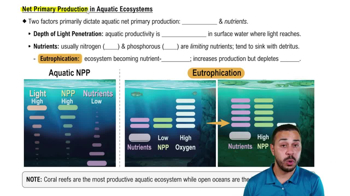Textbook Question
Which of these ecosystems has the lowest net primary production per square meter? a. a salt marsh b. an open ocean c. a coral reef d. a tropical rain forest
663
views
 Verified step by step guidance
Verified step by step guidance



Which of these ecosystems has the lowest net primary production per square meter? a. a salt marsh b. an open ocean c. a coral reef d. a tropical rain forest
The discipline that applies ecological principles to returning degraded ecosystems to a more natural state is known as a. restoration ecology. b. thermodynamics. c. eutrophication. d. biogeochemistry.
Nitrifying bacteria participate in the nitrogen cycle mainly by a. converting nitrogen gas to ammonia. b. releasing ammonium from organic compounds, thus returning it to the soil. c. converting ammonium to nitrate, which plants absorb. d. incorporating nitrogen into amino acids and organic compounds.